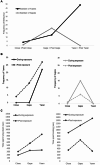Chimpanzees yawn when observing an android yawn
- PMID: 40473760
- PMCID: PMC12141620
- DOI: 10.1038/s41598-025-98639-z
Chimpanzees yawn when observing an android yawn
Abstract
This study explores contagious yawning in adult chimpanzees (Pan troglodytes) in the presence of a non-biological humanoid agent, an android. Chimpanzees observed an android portraying specific facial expressions, including yawns and gapes. The results showed that adult chimpanzees exhibited across-agent yawn contagion, with a graded response: the highest contagion occurred when the android displayed a fully wide-open mouth (Yawn condition), a reduced response when the mouth was partially opened (Gape condition), and no contagion when the android's mouth was closed (Close condition). Additionally, chimpanzees engaged in behaviours associated with drowsiness, such as gathering bedding materials, constructing nests, and lying down, while observing the android yawning. This suggests that yawning by an unfamiliar model may act as a contextual cue for rest, rather than merely triggering a motor resonance response. These findings contribute to the understanding of non-human primates' susceptibility to contagiously induced behaviours, specifically yawns, even when triggered by an artificial agent. This study highlights the role of social factors in shaping yawn contagion and calls for further research on cross-species and cross-agent interactions.
Keywords: Android; Chimpanzee; Contagion; Empathy; Yawning.
© 2025. The Author(s).
Conflict of interest statement
Declarations. Competing interests: The authors declare no competing interests.
Figures



Similar articles
-
Chimpanzees show a developmental increase in susceptibility to contagious yawning: a test of the effect of ontogeny and emotional closeness on yawn contagion.PLoS One. 2013 Oct 16;8(10):e76266. doi: 10.1371/journal.pone.0076266. eCollection 2013. PLoS One. 2013. PMID: 24146848 Free PMC article.
-
Contagious yawning in chimpanzees.Proc Biol Sci. 2004 Dec 7;271 Suppl 6(Suppl 6):S468-70. doi: 10.1098/rsbl.2004.0224. Proc Biol Sci. 2004. PMID: 15801606 Free PMC article.
-
Observational data reveal evidence and parameters of contagious yawning in the behavioral repertoire of captive-reared chimpanzees (Pan troglodytes).Sci Rep. 2019 Sep 13;9(1):13271. doi: 10.1038/s41598-019-49698-6. Sci Rep. 2019. PMID: 31519942 Free PMC article.
-
Non-human primates: a comparative developmental perspective on yawning.Front Neurol Neurosci. 2010;28:63-76. doi: 10.1159/000307082. Epub 2010 Mar 26. Front Neurol Neurosci. 2010. PMID: 20357464 Review.
-
The neuroethology of spontaneous mimicry and emotional contagion in human and non-human animals.Neurosci Biobehav Rev. 2020 Apr;111:149-165. doi: 10.1016/j.neubiorev.2020.01.020. Epub 2020 Jan 20. Neurosci Biobehav Rev. 2020. PMID: 31972204 Review.
References
-
- Leite, I. et al. The influence of empathy in human-robot relations. Int. J. Hum. Comput. Stud.71 (3), 250–260 (2013).
-
- Berlin, M., Gray, J., Thomaz, A. L. & Breazeal, C. Perspective taking: An organizing principle for learning in human-robot interaction. In AAAI 2, pp. 1444–1450 (2006).
-
- Lemaignan, S., Warnier, M., Akin Sisbot, E., Clodic, A. & Alami, R. Artificial cognition for social human-robot interaction: an implementation. Artif. Intell.247, 45–69 (2017).
-
- Wood, A., Rychlowska, M., Korb, S. & Niedenthal, P. Fashioning the face: sensorimotor simulation contributes to facial expression recognition. Trends Cogn. Sci.20 (3), 227–240 (2016). - PubMed
-
- Schillaci, G. Sensorimotor learning and simulation of experience as a basis for the development of cognition in robotics. (2014).
MeSH terms
LinkOut - more resources
Full Text Sources

